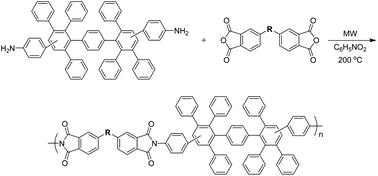当前位置:
X-MOL 学术
›
Polym. Chem.
›
论文详情
Our official English website, www.x-mol.net, welcomes your
feedback! (Note: you will need to create a separate account there.)
Polyarylene polyimides with hydrocarbon and semi-fluorinated backbones: synthesis, characterization, and properties
Polymer Chemistry ( IF 4.1 ) Pub Date : 2020-09-01 , DOI: 10.1039/d0py00814a Stephen M. Budy 1, 2, 3, 4 , Jamie Dore Hall 1, 2, 3, 4 , David Y. Son 1, 2, 3, 4
Polymer Chemistry ( IF 4.1 ) Pub Date : 2020-09-01 , DOI: 10.1039/d0py00814a Stephen M. Budy 1, 2, 3, 4 , Jamie Dore Hall 1, 2, 3, 4 , David Y. Son 1, 2, 3, 4
Affiliation

|
A series of six new polyarylene polyimides (PAPI) was prepared from a highly phenylated phenylenediamine synthesized via a Diels–Alder reaction. The diamine was reacted with a variety of dianhydrides using a one-step microwave-assisted step-growth polycondensation reaction to give the PAPI. The polymerizations were complete in 10 to 30 minutes using isoquinoline as catalyst. Yields as high as 99% were achieved using nitrobenzene as the solvent. A semi-fluorinated dianhydride was included to compare polyimide properties to the hydrocarbon materials. Full characterization was carried out via1H and 19F nuclear magnetic resonance spectroscopy and attenuated total reflectance Fourier transform infrared spectroscopy. Thermal properties were characterized via thermal gravimetric analysis and differential scanning calorimetry. The onset of thermal degradation was approximately 550 °C in nitrogen and air atmospheres while the char yields at 1000 °C in nitrogen were almost 70%. The semi-fluorinated polyarylene polyimide exhibited the highest char yield. Glass transition temperatures were in the range of 355 to 387 °C, with the semi-fluorinated material possessing the highest Tg and the most rigid material affording the lowest Tg. Optical transparency was good in all the materials, with the semi-fluorinated material having the largest optical window in the UV-Vis region. The polymers were colorless or pale yellow solids. Solubility was excellent in chloroform, tetrahydrofuran, toluene, and cyclohexanone. We are currently interested in these materials and precursors for fuel cell and gas separation membranes, coatings, fibers, adhesives, and composite applications.
中文翻译:

具有烃和半氟化骨架的聚亚芳基聚酰亚胺:合成,表征和性能
由通过Diels-Alder反应合成的高度苯基化苯二胺制备了一系列六个新的聚亚芳基聚酰亚胺(PAPI)。使用一步微波辅助的逐步生长缩聚反应,使二胺与各种二酐反应,得到PAPI。使用异喹啉作为催化剂,聚合反应在10至30分钟内完成。使用硝基苯作为溶剂,收率高达99%。包括半氟化二酐,以比较聚酰亚胺与烃类材料的性能。通过1 H和19进行全面表征F核磁共振光谱和衰减全反射傅里叶变换红外光谱。通过热重分析和差示扫描量热法表征热性能。在氮气和空气气氛中,热降解的起始温度约为550°C,而在氮气中,1000°C时,炭的产率几乎为70%。半氟化聚亚芳基聚酰亚胺表现出最高的炭收率。玻璃化转变温度在355至387°C的范围内,其中半氟化材料的T g最高,而最坚硬的材料的T g最低。。在所有材料中,光学透明性都很好,其中半氟化材料在UV-Vis区域具有最大的光学窗口。聚合物为无色或浅黄色固体。在氯仿,四氢呋喃,甲苯和环己酮中的溶解性极好。目前,我们对用于燃料电池和气体分离膜,涂层,纤维,粘合剂和复合材料应用的这些材料和前体感兴趣。
更新日期:2020-10-13
中文翻译:

具有烃和半氟化骨架的聚亚芳基聚酰亚胺:合成,表征和性能
由通过Diels-Alder反应合成的高度苯基化苯二胺制备了一系列六个新的聚亚芳基聚酰亚胺(PAPI)。使用一步微波辅助的逐步生长缩聚反应,使二胺与各种二酐反应,得到PAPI。使用异喹啉作为催化剂,聚合反应在10至30分钟内完成。使用硝基苯作为溶剂,收率高达99%。包括半氟化二酐,以比较聚酰亚胺与烃类材料的性能。通过1 H和19进行全面表征F核磁共振光谱和衰减全反射傅里叶变换红外光谱。通过热重分析和差示扫描量热法表征热性能。在氮气和空气气氛中,热降解的起始温度约为550°C,而在氮气中,1000°C时,炭的产率几乎为70%。半氟化聚亚芳基聚酰亚胺表现出最高的炭收率。玻璃化转变温度在355至387°C的范围内,其中半氟化材料的T g最高,而最坚硬的材料的T g最低。。在所有材料中,光学透明性都很好,其中半氟化材料在UV-Vis区域具有最大的光学窗口。聚合物为无色或浅黄色固体。在氯仿,四氢呋喃,甲苯和环己酮中的溶解性极好。目前,我们对用于燃料电池和气体分离膜,涂层,纤维,粘合剂和复合材料应用的这些材料和前体感兴趣。











































 京公网安备 11010802027423号
京公网安备 11010802027423号